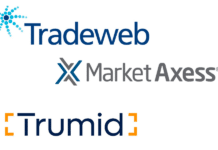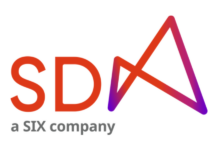
A white paper published by Flow Traders and WBR Research* has identified several key indicators that execution quality is being enhanced by new ways of trading, and trading counterparties.
Most survey respondents saw major benefits in portfolio trading (PT), most notably to save costs, save time and ensure certainty of execution.
Existing users indicated that their usage of PT was up 50%, with PT now representing around 6% of the total credit volumes traded daily in Europe and the US. In 2019 this was 0% in Europe and around 2% in the US. Currently, there doesn’t seem to be a single common way of consuming PT axes.
While these are also available in a limited capacity on third-party platforms, 41% of respondents said they would like access to the dealer portfolio axes/ interests to be able to target quicker and more efficient execution.
The survey also indicated that the rise in algorithmic trading has improved the credit market, with 54% of respondents stating it has had a positive impact on the execution of odd lots. The majority of the respondents said that algos improved odd lots, larger blocks and relationships with dealers, while 33% of respondents also mentioned that algos have improved price discovery.
Indicators of past performance – such as historical hit ratios, best indicative prices on screen (pre-trade information) and relationships – still seem to dominate dealer selection.
Based on market data and the research, electronic trading in European credit has increased dramatically over the last few years, with 45% of € investment-grade (IG) credit now executed electronically, reaching 75% on a ticket-count basis. The COVID-19 pandemic has further accelerated this trend, with 64% of respondents in the survey saying they increased the amount of request for quotes (RFQs) on platforms.
This increase has contributed to the approaching inflection point of electronification in credit markets, comparable to what we have witnessed in other markets, such as foreign exchange (FX), US equity options and exchange-traded funds (ETFs). This transition is being driven by better pre- and post-trade information, the rise of algorithmic trading and new trading protocols being embraced by the buy- and sell-side. Initially driven by regulation such as MiFID II, it is likely that the regulatory landscape will continue to accelerate this electronification trend. According to the survey, the pending Central Securities Deposit Regulation (CSDR) means that the market is actively looking at the optimization of reporting and automation of processes to minimize buy-in risk and penalties.
The survey also indicated that Investors are interested in using trading strategies and new trading protocols, such as auctions, matching platforms, firm prices, two-way pricing/request for market (RFM), PT, and central limit order books (CLOBs) via dealer pricing API protocols. There seems to be a clear preference for trading protocols that provide pre-trade transparency and execution certainty, and address concerns around data leakage such as firm/live prices and RFM. The majority of respondents (52%) measure execution slippage by reconciling executed prices and comparing them to pre-trade indicative or composite prices, and this analysis becomes even more efficient if reconciliation is based on firm prices.
In addition to the increase in new trading protocols, there is room for additional platforms and direct pricing, according to 37% of respondents. The latter is limited by the order management system (OMS) and execution management system (EMS), as well as the technology spend. The survey also indicated that liquidity trees defined as prices by size bucket and portfolio axes are also on the mind of investors.
©Markets Media Europe 2025














